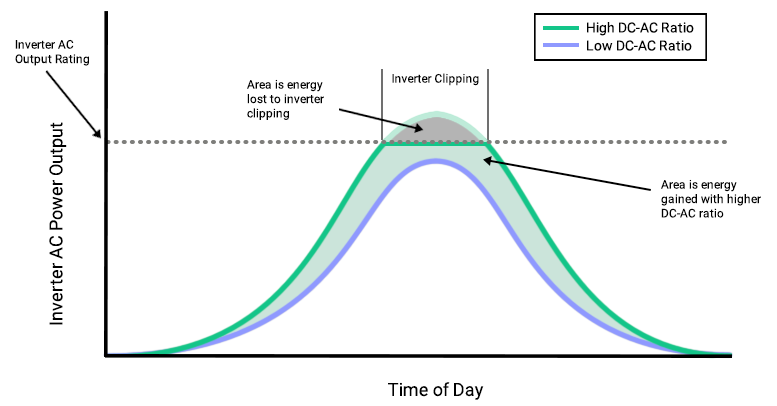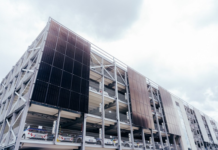
As you likely know, solar cells produce direct current (DC) electricity, which is then converted to alternating current (AC) electricity by an inverter. Converting energy from DC to AC allows you to deliver it to the grid or use it to power buildings, both of which operate with AC electricity. When designing a solar installation, and selecting the inverter, we must consider how much DC power will be produced by the solar array and how much AC power the inverter is able to output (its power rating).
In this article, we’ll discuss some important considerations for solar projects to ensure that the inverters in your designs are appropriately sized. Specifically, we’ll examine the relationship between the amount of energy your solar array produces and the amount of power your inverter can output, and we’ll introduce the concept of inverter clipping.
Understanding the DC-to-AC ratio
The DC-to-AC ratio is defined as the ratio of installed DC capacity to the AC power rating of the inverter. It often makes sense to oversize a solar array, such that the DC-to-AC ratio is greater than 1. This allows for a greater energy harvest when production is below the inverter’s rating, which it typically is for most of the day.
Consider the graph of energy production as a function of time of day in Figure 1. The purple line shows a typical bell curve of AC output power peaking at noon, just below the rating of the inverter indicated by the dashed line. If we increase the size of the solar array by adding more panels, thereby increasing the DC-to-AC ratio of the system (as illustrated by the green curve), we can harvest more energy throughout the day. The area between the green and purple curves is the energy that is gained by increasing the DC-to-AC ratio.

Inverter clipping
While oversizing the solar array relative to the inverter’s rating can help your system capture more energy throughout the day, this approach is not without costs. What Figure 1 also shows is an effect called inverter clipping, sometimes referred to as power limiting. When the DC maximum power point (MPP) of the solar array — or the point at which the solar array is generating the most amount of energy — is greater than the inverter’s power rating, the “extra” power generated by the array is “clipped” by the inverter to ensure it is operating within its capabilities. This leads to a flatline in the green curve, and thus lost energy production, during peak production hours. The inverter effectively prevents the system from reaching its MPP, capping the power at the inverter’s nameplate power rating.
It is crucial to model inverter clipping in order to properly design a system with a DC-to-AC ratio greater than 1, as well as in regions that frequently see an irradiance larger than the standard test conditions (STC) irradiance of 1000 W/m2(because higher levels of irradiance lead to higher power output). Consider a south-facing, 20°-tilt ground mount system in North Carolina (35.37° latitude) with a 100 kW central inverter. If we design the system with a DC-to-AC ratio of 1, it will never clip; however, we will also not fully utilize the AC capacity of the inverter.
If we want a larger system size, we could place another 100-kW block (a section of solar panels connected to an inverter), or we can pack more DC power generation onto our first inverter. The latter allows us to save cost by not purchasing another inverter and, like we saw in Figure 1, we can still harvest more energy during off-peak hours. If we choose a high DC-to-AC ratio, we will also sacrifice some amount of energy to inverter clipping. The inherent design trade-off is between the cost of purchasing and installing a new inverter and the value of the energy lost due to inverter clipping.
Table 1 summarizes energy production results for three DC-to-AC ratios, as well as how much energy is clipped, for the aforementioned ground mount system. If a simulation tool does not properly model clipping, the designer may be led to believe that, for example, the 100 kW inverter can fully handle the DC-to-AC ratio of 1.5 and output 228.24 MWh, whereas in reality 11.0 MWh would be lost to clipping. This could lead to a system that underperforms relative to the expected result. Knowing how much energy is clipped allows a designer to understand how effective the oversizing scheme is at increasing energy harvest and determine what system configuration is the most cost-effective, in order to make an informed decision about how much DC power to connect to the inverter.

Aurora’s solar design and sales software automatically takes inverter clipping into account in its performance simulations. The amount of energy that is clipped throughout the year, and the percentage of total energy that amount represents, is presented to the user as a simulation warning and in our system loss diagram. Combined with Aurora’s NEC validation report, which ensures designs do not violate any electrical or mechanical constraints or rules of the National Electric Code (NEC), this feature allows users to be confident that the systems they design are appropriately-sized and code-compliant.
Key takeaways
- Oversizing a solar array relative to an inverter’s rating (DC-to-AC ratio greater than one) allows for increased energy harvest throughout most of the day, especially in the morning and late afternoon.
- When a DC array produces more energy than the inverter is rated to handle, the inverter clips the excess power and caps its output at its rated power (an effect known as inverter clipping).
- An alternate approach to increase energy production while avoiding inverter clipping would be to include another inverter. When deciding what approach to take, designers must consider the trade-off between the cost of purchasing and installing an additional inverter compared to the value of the energy that will be lost due to inverter clipping if they oversize the solar array.
- When estimating the energy production of a solar project design, it’s important that your performance simulations take inverter clipping into account (as Aurora does automatically), in order to ensure production results accurately reflect the system size of the design.
Source: www.solarpowerworldonline.com


















